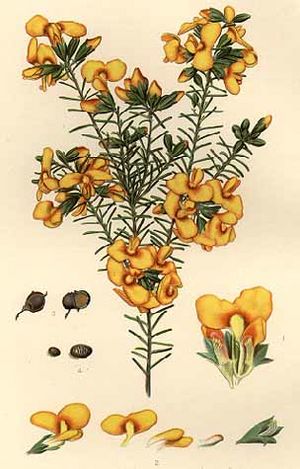Eggs and bacon facts for kids
Quick facts for kids Eggs and bacon |
|
|---|---|
 |
|
| Scientific classification | |
| Genus: |
Dillwynia
|
| Species: |
retorta
|
Dillwynia retorta, often called eggs and bacon, is a pretty flowering plant. It's a type of shrub that belongs to the pea family, called Fabaceae. You can find this plant growing naturally in parts of New South Wales and Queensland, Australia. It usually stands upright and has thin, smooth leaves. Its flowers are bright yellow with interesting red markings, making them look a bit like eggs and bacon!
Contents
What Does Eggs and Bacon Look Like?
Dillwynia retorta is a small shrub that can grow up to 3 meters (about 10 feet) tall. Its stems are covered in short, soft hairs. The leaves are narrow and look a bit like needles. They are usually between 4 and 12 millimeters long, and they often twist in a spiral shape. The leaves can be smooth or have tiny bumps.
The flowers grow in clusters at the ends of the branches or where leaves meet the stem. Each cluster can have up to 9 flowers. The flowers are on a short stalk called a peduncle, which is usually 0 to 2 centimeters long. Small leaf-like parts called bracts are found mostly below the flowers. These are about 1 to 2 millimeters long.
The green parts that protect the flower bud, called the calyx, are 3 to 6 millimeters long. They can be smooth or have tiny hairs on the outside. The largest petal of the flower is yellow and can be 5 to 12 millimeters long. This main petal often has a reddish color in its center. After the flower blooms, it forms a smooth seed pod that is 4 to 7 millimeters long. This plant usually flowers from June to November.
How Did It Get Its Name?
This plant was first officially described in 1799 by a scientist named Johann Christoph Wendland. He called it Pultenea retorta. Later, in 1917, another scientist named George Claridge Druce changed its name to Dillwynia retorta. This new name was published in a special report about plants.
Plant Life and Animals
Dillwynia retorta is an important plant for a type of insect called the jewel beetle. It is a "host plant" for the jewel beetle species Ethonion jessicae. This means the beetle uses the plant for food or shelter during its life cycle.
See also
 In Spanish: Desayuno completo para niños
In Spanish: Desayuno completo para niños


